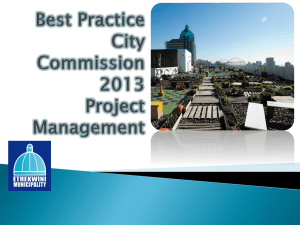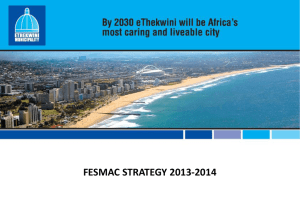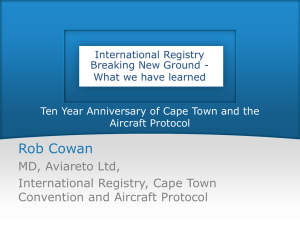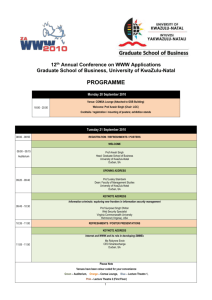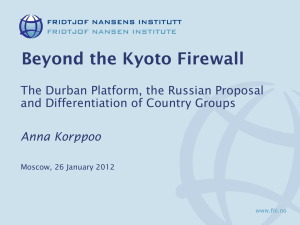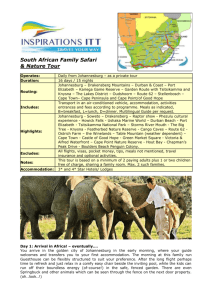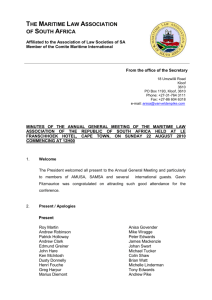Chance-2-sustain
advertisement
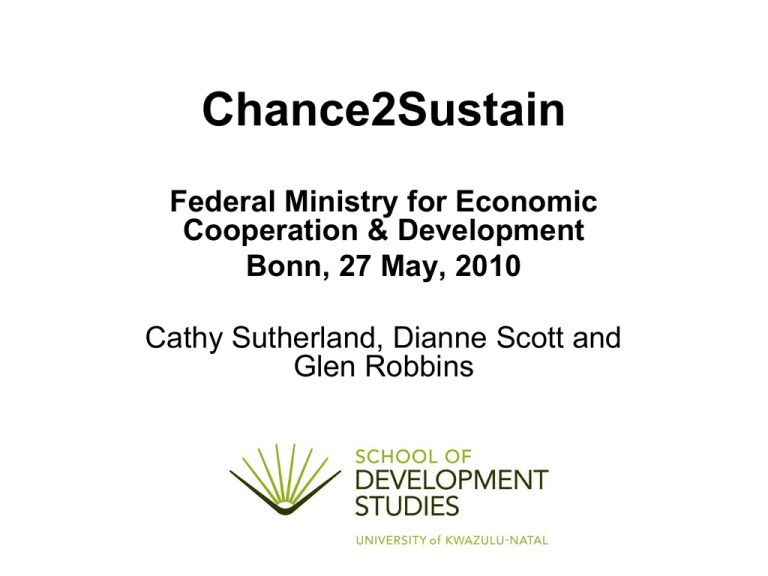
Chance2Sustain Federal Ministry for Economic Cooperation & Development Bonn, 27 May, 2010 Cathy Sutherland, Dianne Scott and Glen Robbins Structure 1. 2. 3. 4. South African team Research questions Durban and Cape Town Participatory spatial planning 1. South African Team • Core Team • Research Associates Department of Environmental and Geographical Science University of Cape Town 2. Research questions • City futures: How do we conceptualise and frame fast growing cities in the ‘developing world’ in relation to sustainability (ecological, social, economic and governance dimensions) • Production of space: How is space produced? abstract, representative spaces and everyday lived space. • Participation: What negotiation, participation & deliberation takes place in the production of space? • Knowledge: What is the process and politics of knowledge construction? • Planning: To what extent do planning and environmental management processes towards more sustainable cities, include participatory knowledge? GOVERNANCE Networks and multiple actors/stakeholders WP5 Participatory spatial planning ECONOMIC DEVELOPMENT Sustainable economic growth WP2 Large scale infrastructure projects WP6 Fiscal decentralisation SUSTAINABLE DEVELOPMENT SOCIAL CAPITAL Social networks, Equity ECOLOGICAL Participation INTEGRITY Identity, sense of place Resource conservation WP 4 Policy, politics, WP3 CSO’s and sub-standard Environmental risk settlements Water and energy An urban household in a South African city 3. Durban and Cape Town Two fast growing but very different South African cities • Compare cities within South Africa • Compare SA cities with other cities in the global South Durban • • • • • • • • • African city Service delivery city Economic growth objectives Mega-projects Less divided spatially Political dominance Rural-urban continuum Greenfields development (high value zones) Mix of issues: Growth of demand for water and energy at lower levels of high end consumption, increase in water resources (natural provision) but water supply problems eThekwini Municipality (Durban) Cape Town • • • • • • Global ‘leisure’ city High income tourism boom Divided spatially Politically contested Brownfields development (high value zones) High income consumption (minority) exceeds that of the poor (majority) • Reduction in water resources (natural provision) over time • Protecting the ‘established’ golden goose (nature) City of Cape Town Source: Pithey, 2007 • Common themes – Both fast growing: • Durban: land area grew by 66% post 2000 due to Municipal Systems Act (2000) • Cape Town: land area size grew by 40% between 1977 and 2006, city consumes 900 hectares of undeveloped land per year – Tasked with overcoming the spatial divisions and inequality caused by apartheid and endemic poverty – Similar population with high numbers of poor residents (approximately 1.6% annual growth rate) • Cape Town – 3.5 million people or 800 000 households – 50% Cape Town residents classified as poor • Durban – 3.5 million people – 33.1% of Durban residents classified as poor (different poverty line measures) – Unemployment levels of 43% (Durban), 15% -21% (Cape Town) – Urban sprawl (Durban has greater sprawl than Cape Town) with low urban density by international standards – Highest urban density in poor areas – Large housing backlogs – Investments in urban infrastructure (services), energy and transportation systems have not kept up with rapid growth – Unequal cities: gap between the have’s and the have nots in all aspects of urban life – Market versus state led development of the city – Active civil society: heritage of apartheid and part of post-apartheid transformation • Increase in civil action as a result of poor delivery of the state – Separate environment and planning processes and procedures – Integration of brown and green agenda issues – Both cities under intense social, economic and environmental pressure – Both located in global environmental hotspots or zones of high biodiversity – Both impacted by HIV\Aids (Durban has greater impact) – Both have a separate environmental management function in local government – Comparative and co-operative sustainability and climate change programmes (coastal cities) – Economic activity: Manufacturing is dominant in Durban, finance, services and commerce is dominant in Cape Town – Unitary cities: Cape Town Unicity and eThekwini Municipality (Durban) • To ensure greater equality between rich and poor areas and to allow for standardised service delivery – Unitary budget for both cities with a focus on the poorest of the poor – Both impacted by the role of consultants: South Africa may be termed a consultant state WP5: Participatory spatial planning discourses • EU Research • Democratic urban governance and planning, i.e. procedural justice – necessary for sustainable decisionmaking • Production and sharing of knowledge for urban development (public & private sector, consultants, civil society) • Production of space: abstract representative spaces and everyday lived worlds • Existing research • Spatial planning discourses • Relationship between society, space, environment, knowledge production and democracy Spatial planning of South Durban Residents call South Durban ‘home’ Wide range of social organisations that link into the broader social network and reflect everyday lived worlds Logistics zone for port Proposed research • • • • • • • Participatory spatial planning North Coast corridor Local area planning ‘Competency groups’ (Whatmore, 2009) Expert and lay knowledge – integration. Contestation Knowledge production Conclusion • EU project enables our team to integrate and advance a wide range of our existing theoretical and empirical work • EU project enables our team to extend our current work by considering these issues through – new theoretical lenses, – different questions and – in comparison to other fast growing developing world cities • We are very excited about this opportunity and look forward to working with our team Acknowledgements • eThekwini Municipality • City of Cape Town • Sustainability Institute, Stellenbosch University

